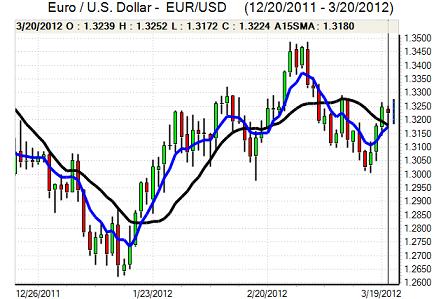EUR/USD
The Euro was capped in the 1.3250 area against the dollar in Europe on Tuesday and dipped to test lows below 1.32 ahead of the US open. There was a notable absence of longer-term market participants which increased the influence of short-term funds. There was a high degree of market activity on the crosses and players also looked to trigger stop losses.
There were further concerns surrounding the Chinese growth outlook which maintained a defensive tone towards risk appetite and provided net dollar support, especially with increased concerns that German exporters would be damaged. Dutch political tensions also had some negative Euro impact.
The US housing starts data was close to expectations at an annual rate of 0.70mn for February while permits increased to an annual rate of 0.72mn, the highest figure since 2008. The data helped maintain a degree of optimism towards the US economy and helped push US Treasury yields higher. There was still some suspicion that the data should have been even stronger given the favourable weather conditions during the month.
In comments on Tuesday, Fed Chairman Bernanke stated that it would be a mistake to withdraw monetary stimulus too quickly, maintaining expectations that the Fed will be very cautious in removing monetary stimulus which will also limit dollar support. Regional President Kocherlakota stated that there was no case for further accommodation at this stage.
Immediate global growth fears eased slightly during the New York session with the Euro moving back above the 1.32 level in choppy trading conditions. The advance extended to the 1.3280 area during the Asian session as US dollar support dipped again with Greek parliamentary approval of the bailout deal providing some net support.

Source: VantagePoint Intermarket Analysis Software
Call now and you will be provided with FREE recent forecasts
that are up to 86% accurate* 800-732-5407
If you would rather have the recent forecasts sent to you, please go here
Yen
The dollar initially pushed to the 83.70 area against the yen on Tuesday before dipping sharply to test support below 83.40 as risk appetite deteriorated. There was still net support from rising US yields which helped limit the scope for yen gains and the dollar re-tested resistance near 83.80 later in the session.
The global growth outlook will remain under close scrutiny and there will be an increased probability of defensive yen support if there are increased concerns surrounding the Chinese outlook.
There was further evidence of yen selling on rallies with funds looking to extend short positions against the currency. There was still some caution over selling the yen aggressively given the seasonal risk of capital repatriation ahead of the fiscal year-end.
Sterling
Sterling found support below 1.5850 against the dollar on Tuesday and edged higher to test resistance in the 1.5880 region, although ranges were generally narrow.
The headline consumer inflation rate was in line with expectations as it declined to 3.4% from 3.6%, although the RPI rate was higher than expected and there was some disappointment that the rate did not decline further as energy costs increased.
There was confidence of a firmer UK growth outlook in Wednesday’s 2012 budget which helped underpin Sterling with expectations that the OBR would increase its growth forecast. There were also expectations that the Bank of England would take a more hawkish outlook on inflation in the latest MPC minutes.
These expectations were fuelled by comments from MPC member Dale who stated that it was just as likely that inflation would be above or below the 2% level on a two-year horizon. The latest CBI industrial survey dipped to -8 for March from -3. The Euro edged higher to just above 0.8350 as it advanced generally on the crosses.
Swiss franc
Dollar rallies were capped in the 0.9150 region against the franc on Tuesday and dipped back to the 0.91 area as ranges narrowed. The Euro was unable to make headway against the Swiss currency during the day.
The latest industrial production data was stronger than expected with a 7.9% increase for the fourth quarter. The IMF stated that the National Bank should remove the Euro minimum level once the deflation threat had eased, although it gave no timescale for such a move.
The franc should lose some support if there is a gain in US yields, although this is likely to be offset by doubts over the global growth outlook if Asian concerns intensify.

Source: VantagePoint Intermarket Analysis Software
Call now and you will be provided with FREE recent forecasts
that are up to 86% accurate* 800-732-5407
If you would rather have the recent forecasts sent to you, please go here
Australian dollar
The Australian dollar remained under pressure during Tuesday with a test of support in the 1.05 area and a break below helped trigger further stop-loss selling to lows in the 1.0460 region. The Australian currency was undermined by further concerns over the Chinese economy which increased unease over the regional outlook.
There was some institutional support at lower levels which helped curb any further selling pressure on the currency. A similar pattern continued in Asia on Wednesday with Australian rallies curbed by a weaker tone in regional equity markets as regional doubts remained a significant feature.



